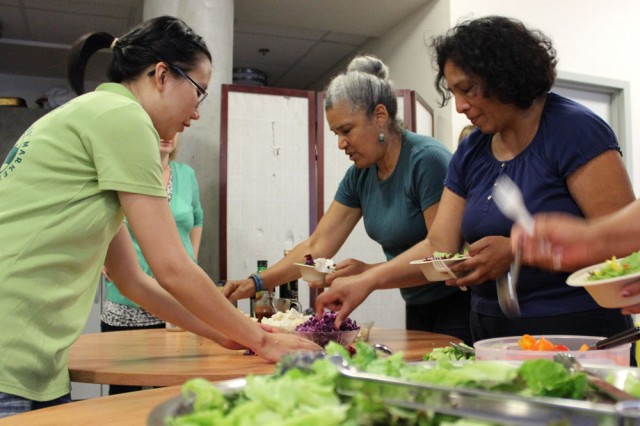“What do all of these foods have in common?” Ricci asks.
“They all come from plants,” shouts out Paula Marie Parker.
Parker and the others are all students in a program at the Native American Health Center called VeggieRx, which teaches participants about nutrition and the merits of incorporating more fruits and vegetables and physical activity in their lives and the lives of their families.
The 14-week program is exclusively for people who are overweight, obese or at risk for diabetes. They get hands-on nutrition lessons and learn to cook healthy meals while tracking their physical activity and weight loss. The program has been going for several years and is run by the nonprofit Fresh Approach which provides vouchers for to buy fresh fruits and vegetables.
Melissa Cannon, a dietitian at the Native American Health Center, reached out to Fresh Approach and asked them to bring VeggieRx to her clinic this year.
VeggieRx is by far the most popular nutrition class her clinic runs, Cannon says. A big driver, she says: “They get free food.”
The hope of these nutrition programs, Cannon says, is to break down some of the barriers to educating about health and nutrition which can be especially tough for low-income and multi-ethnic families. What’s surprised her the most about offering VeggieRx has not only been the turnout — they have about 22 participants who consistently attend — but also the way that many of the participants have formed a healthy eating camaraderie with one another.
“We have a lot of people who did our six-week Food as Medicine course who are now coming to this class,” she says. “They’ve gotten to know each other, and that’s really neat.”
One of those people is Robert Davila, 60, of Oakland, who said the hands-on nature of VeggieRx has made a real difference in his life. Cannon is his dietitian and encouraged him to sign up. As a diabetic, he said learning about food labels has proved to be an eye-opener. He said he’s made little changes in his diet since starting the program, including switching out most of his processed foods for whole grains.
“I’ve really been surprised,” he says. “I was hesitant at first, but it’s really been worth it to me. I didn’t really realize how important something like a food label could be to my health.”
"Social Component Is Really Important"
Dr. Jennifer Falbe, a fellow at the UC Berkeley School of Public Health has studied community health programs in depth. She described multiple barriers to teaching health and nutrition to multi-ethnic, low income groups including language barriers, limited access to the internet or transportation, and some families just needing one-on-one support to navigate signing up for a program or service.
One key factor in keeping people involved in health programs, she says, is a shared social connection.
“Having a social component is really important to keep people coming,” she said. “That’s probably a big part of the effectiveness of Weight Watchers.”
That social connection is one big reason Mindy Woolbert, 62, from Oakland, enjoys the program. She comes with her sister and her sister-in-law. Together, she said, they try to keep each other accountable.
“No matter how many times you hear how you’re supposed to eat healthy, you can always hear it once more,” she said. “I didn’t like vegetables and fruit, but now we’re all eating more of them.”
Falbe adds that because minority communities experience a much higher prevalence of obesity and chronic disease associated with being overweight, it’s important to provide greater attention. In an ongoing study that links low-income overweight or obese children and families with physical activity programs in San Francisco, Falbe’s team is finding that having someone in the clinic work closely with families and individuals as they sign up, as well as providing one-on-one support in languages other than English, can often be effective in connecting families with community programs and convincing them to continue to attend.
Cannon also says many people she sees are reluctant to shop at farmers markets, a specific barrier that VeggieRx addresses. Her clients tend to see farmers markets as expensive places to shop – and geared to white people.
“There’s a real stigma attached,” she said. “Most of our population here is multi-ethnic, and that’s a barrier in it of itself.”
Fresh Approach provides $7 per person per week in vouchers to be used at farmers markets, and participants are drawn to the extra benefits.
“We want to provide enough to allow them to make healthy changes in their household,” said. Laura deTar, nutrition program manager for Fresh Approach
Fresh Approach’s dataset is limited but shows effectiveness. In a follow up earlier this year with 13 families who participated in the program in 2012, they found that nearly 70 percent of the families said they were eating more fruits and veggies and were more physically active. Eighty-four percent reported that they had maintained or reduced their body mass Index.
Back in the classroom, the Fresh Approach team is bringing in bowls of colorful fruits and vegetables they chopped just minutes before. All the produce, which includes things like beets, Armenian cucumbers, Asian pears and heirloom tomatoes, was purchased earlier that day at the uptown Oakland farmers market.
DeTar demonstrates creating a balsamic dressing from scratch while instructor Ricci begins reading the ingredients off the back of a store-bought bottle of salad dressing.
“How much sugar does that have?” asks one participant.
“Let’s see … 27 grams per serving,” answers Ricci. That's almost seven teaspoons of sugar.
As the list goes on, more and more of the crowd begin to shake their heads.
Later, after chowing down on their salads -- with healthier home made salad dressing -- Paula Marie Parker talked about why she loved the class.
“Knowledge is power and most of us here didn’t study nutrition and were raised by parents who didn’t either. Here it’s free and the staff is caring.”
